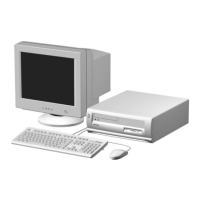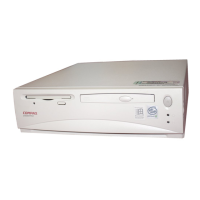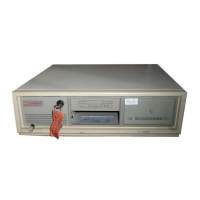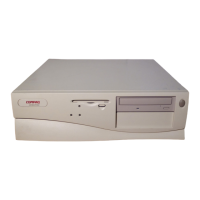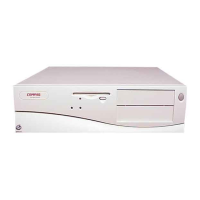Do you have a question about the Compaq Deskpro EP 6233 and is the answer not in the manual?
Overview of the guide's purpose and content structure.
Lists of external documentation and online resources for further information.
Explains symbols, formats, and abbreviations used throughout the document.
A comprehensive list of acronyms and abbreviations used in the technical guide.
Overview of the chapter's scope, covering system architecture and processors.
Details standard and optional features of the Compaq Deskpro EP Series.
Covers the physical aspects of the computer's chassis and cabinet layout.
Explains the system's core components and bus structure (Host, PCI, ISA, AGP).
Provides environmental, electrical, and physical specifications for the computers.
Overview of the processor and cache memory subsystem.
Details the 66-MHz slot 1 processor/memory configuration.
Details the 100-MHz slot 1 processor/memory configuration.
Overview of system architecture and support functions.
General description of the PCI bus and its implementation in the system.
Details the Accelerated Graphics Port bus and its operations.
Describes the Industry Standard Architecture bus and its functions.
Explains the system clock signals and their distribution.
Details the RTC and CMOS memory functions and organization.
Covers system I/O mapping, GPIO configuration, and I/O controller configuration.
Discusses system management features like security and power management.
Overview of system I/O interfaces controlled via registers.
Details the EIDE interface, connectors, and programming.
Covers the diskette drive interface, programming, and control registers.
Describes the RS-232 serial interface, programming, and control.
Explains parallel port modes (SPP, EPP, ECP) and programming.
Details keyboard and pointing device interface operation and programming.
Covers USB interface, keyboard considerations, configuration, and connectors.
Overview of power supply and signal distribution methods.
Details power supply components, control, and LEDs.
Describes the 3/5/12 VDC distribution and low voltage regulators.
Illustrates general signal distribution across system components.
Overview of BIOS ROM functions and supported operating systems.
Details system boot functions like Boot Block, QuickBoot, and SilentBoot.
Explains the SPD method for DIMM configuration and detection.
Covers system security, identification, and management via BIOS INT15 functions.
Details Plug 'n Play support and SMBIOS information retrieval.
Describes PM support types: Independent PM, APM, and ACPI.
Information on USB keyboard support during POST and setup.
Procedure for updating the system's BIOS firmware using a diskette.
Lists error codes and probable causes for system issues.
Details power-on messages, beeps, and keyboard LED status for errors.
Covers POST messages for various components like cache, CMOS, diskette, and PCI.
Lists error codes related to processor, FPU, DMA, and memory tests.
Details errors for diskette, serial, modem, hard drive, and video interfaces.
Lists error codes for audio subsystems and network interfaces.
Covers error messages for SCSI, pointing devices, and CEMM operations.
Explains the ASCII character set and how to enter characters using keystrokes.
Describes the standard Compaq keyboard features and types.
Details the keyboard's internal processing and scan code generation.
Describes the audio card, its features, and compatibility.
Details the audio card's architecture, interfaces, and processing methods.
Covers audio card configuration, control registers, and PCM modes.
Lists the technical specifications for the audio card.
Overview of the ATI RAGE IIC graphics card features.
Details the ATI RAGE IIC controller and its supported software.
Lists supported 2D and 3D graphics display modes.
Explains PCI configuration and standard VGA control registers.
Covers monitor power control and card power consumption.
Describes monitor, memory expansion, and multimedia connectors.
Overview of the ATI RAGE PRO AGP graphics card.
Details the ATI RAGE PRO controller, memory, and BIOS.
Lists supported 2D graphics display modes and SGRAM usage.
Explains PCI configuration and standard VGA control registers.
Covers monitor power management according to DPMS protocol.
Describes monitor and media port connectors.
Overview of the Diamond Fire AGP graphics card.
Details the NVIDIA RIVA 128 controller and software support.
Lists supported 2D graphics display modes and SGRAM usage.
Explains PCI configuration and standard VGA control registers.
Covers monitor power management according to DPMS protocol.
Describes monitor and media port connectors.
Overview of the guide's purpose and content structure.
Lists of external documentation and online resources for further information.
Explains symbols, formats, and abbreviations used throughout the document.
A comprehensive list of acronyms and abbreviations used in the technical guide.
Overview of the chapter's scope, covering system architecture and processors.
Details standard and optional features of the Compaq Deskpro EP Series.
Covers the physical aspects of the computer's chassis and cabinet layout.
Explains the system's core components and bus structure (Host, PCI, ISA, AGP).
Provides environmental, electrical, and physical specifications for the computers.
Overview of the processor and cache memory subsystem.
Details the 66-MHz slot 1 processor/memory configuration.
Details the 100-MHz slot 1 processor/memory configuration.
Overview of system architecture and support functions.
General description of the PCI bus and its implementation in the system.
Details the Accelerated Graphics Port bus and its operations.
Describes the Industry Standard Architecture bus and its functions.
Explains the system clock signals and their distribution.
Details the RTC and CMOS memory functions and organization.
Covers system I/O mapping, GPIO configuration, and I/O controller configuration.
Discusses system management features like security and power management.
Overview of system I/O interfaces controlled via registers.
Details the EIDE interface, connectors, and programming.
Covers the diskette drive interface, programming, and control registers.
Describes the RS-232 serial interface, programming, and control.
Explains parallel port modes (SPP, EPP, ECP) and programming.
Details keyboard and pointing device interface operation and programming.
Covers USB interface, keyboard considerations, configuration, and connectors.
Overview of power supply and signal distribution methods.
Details power supply components, control, and LEDs.
Describes the 3/5/12 VDC distribution and low voltage regulators.
Illustrates general signal distribution across system components.
Overview of BIOS ROM functions and supported operating systems.
Details system boot functions like Boot Block, QuickBoot, and SilentBoot.
Explains the SPD method for DIMM configuration and detection.
Covers system security, identification, and management via BIOS INT15 functions.
Details Plug 'n Play support and SMBIOS information retrieval.
Describes PM support types: Independent PM, APM, and ACPI.
Information on USB keyboard support during POST and setup.
Procedure for updating the system's BIOS firmware using a diskette.
Lists error codes and probable causes for system issues.
Details power-on messages, beeps, and keyboard LED status for errors.
Covers POST messages for various components like cache, CMOS, diskette, and PCI.
Lists error codes related to processor, FPU, DMA, and memory tests.
Details errors for diskette, serial, modem, hard drive, and video interfaces.
Lists error codes for audio subsystems and network interfaces.
Covers error messages for SCSI, pointing devices, and CEMM operations.
Explains the ASCII character set and how to enter characters using keystrokes.
Describes the standard Compaq keyboard features and types.
Details the keyboard's internal processing and scan code generation.
Describes the audio card, its features, and compatibility.
Details the audio card's architecture, interfaces, and processing methods.
Covers audio card configuration, control registers, and PCM modes.
Lists the technical specifications for the audio card.
Overview of the ATI RAGE IIC graphics card features.
Details the ATI RAGE IIC controller and its supported software.
Lists supported 2D and 3D graphics display modes.
Explains PCI configuration and standard VGA control registers.
Covers monitor power control and card power consumption.
Describes monitor, memory expansion, and multimedia connectors.
Overview of the ATI RAGE PRO AGP graphics card.
Details the ATI RAGE PRO controller, memory, and BIOS.
Lists supported 2D graphics display modes and SGRAM usage.
Explains PCI configuration and standard VGA control registers.
Covers monitor power management according to DPMS protocol.
Describes monitor and media port connectors.
Overview of the Diamond Fire AGP graphics card.
Details the NVIDIA RIVA 128 controller and software support.
Lists supported 2D graphics display modes and SGRAM usage.
Explains PCI configuration and standard VGA control registers.
Covers monitor power management according to DPMS protocol.
Describes monitor and media port connectors.
| Processor | Intel Pentium II |
|---|---|
| Processor Speed | 233 MHz |
| RAM | 32 MB SDRAM |
| Maximum RAM | 384 MB |
| Form Factor | Desktop |
| Operating System | Windows 95 |
| Expansion Slots | 3 PCI |
| Ports | Serial, Parallel |
| Network | 10/100 Ethernet |
